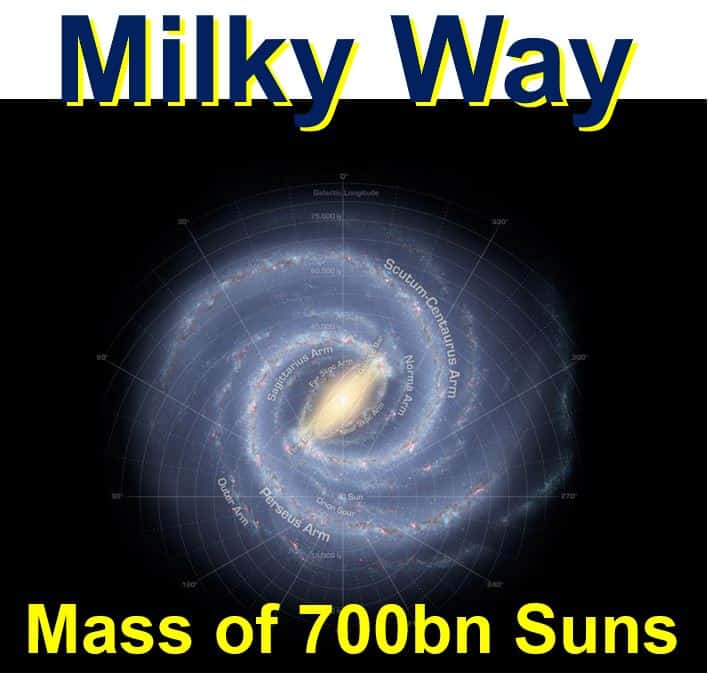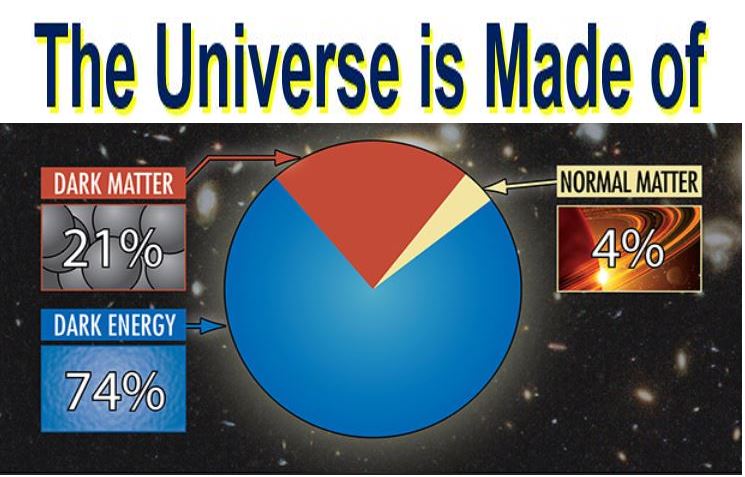The Milky Way – our galaxy – weighs the equivalent of the mass of 700 billion Suns, says Gwendolyn Eadie, a PhD candidate in physics and astronomy at McMaster University in Hamilton, Ontario, Canada.
The Milky Way is a big place – it has a diameter estimated to be between 100,000 and 120,000 light years, but could be up to 180,000 light years across. We are about 27,000 years from the Galactic Centre.
The Universe is an incredibly large place. Scientists say there are about 200 billion galaxies in the observable Universe, i.e. the part we are able to see.
 Graphic view of our Milky Way Galaxy. It weighs the equivalent of approximately 700 billion Suns. Light takes from 100,000 to 120,000 years to travel across it. (Image: nasa.gov. Credit: NASA/Adler/U. Chicago/Wesleyan/JPL-Caltech)
Graphic view of our Milky Way Galaxy. It weighs the equivalent of approximately 700 billion Suns. Light takes from 100,000 to 120,000 years to travel across it. (Image: nasa.gov. Credit: NASA/Adler/U. Chicago/Wesleyan/JPL-Caltech)
According to Ms. Eadie, the Milky Way is 7 x 1011 solar masses. Our Sun, for the record, has 330,000 times the mass of the Earth. The Sun weighs two nonillion (2 followed by 30 zeroes) kilograms.
Milky Way not even the largest galaxy
Ms. Eadie adds: “And our galaxy isn’t even the biggest galaxy.”
According to space.com, the largest galaxy we know of is NGC 6872 – it is 212 million light-years from here and is over five times the size of the Milky Way. The distance between NGC 6872’s huge spiral arms is approximately 522,000 light-years.
Measuring the mass of our own galaxy, or any galaxy for that matter, is especially difficult. A galaxy does not only contain dust, gases, moons, planets, stars plus other objects and material, but also a massive helping of dark matter.
 Gwendolyn Eadie, an accomplished competitive ice dancer, is today becoming well known in the world of astrostatistics, an emerging cross-disciplinary field of physics and astronomy. (Image: dailynews.mcmaster.ca)
Gwendolyn Eadie, an accomplished competitive ice dancer, is today becoming well known in the world of astrostatistics, an emerging cross-disciplinary field of physics and astronomy. (Image: dailynews.mcmaster.ca)
Dark matter is an enigmatic and invisible form of matter that scientists do not yet fully understand – in fact, nobody has directly detected it. We know it exists, because of its gravitational effect on visible objects.
Ever since she started graduate school, Ms. Eadie has been studying the mass of the Milky Way. She uses the positions and velocities of globular star clusters that orbit the Milky Way.
The galaxy’s gravity determines the orbits of globular clusters. A galaxy’s gravity is dictated by its colossal dark matter component.
Unique technique used to measure galaxy’s mass
Ms. Eadie’s research is unique in the technique she devised for using globular cluster (GC) velocities.
A GC’s total velocity has to be measured in two directions: one across the plane of the sky (the proper motion) and one along our line-of-sight. Researchers, unfortunately, have not yet measured the proper motions of all of our Milky Way’s GCs.
Ms. Eadie says she has developed a way to use these velocities that are only partially known, in addition to the fully-known velocities, to estimate the mass of the Milky Way.
 Everything we can see is just the tip of the iceberg of what is out there – it only accounts for about 4% of the total mass and energy of the Universe. Slightly less than one quarter of the Universe consists of dark matter. Most of what is out there consists of dark energy. (Image: hetdex.org)
Everything we can see is just the tip of the iceberg of what is out there – it only accounts for about 4% of the total mass and energy of the Universe. Slightly less than one quarter of the Universe consists of dark matter. Most of what is out there consists of dark energy. (Image: hetdex.org)
She says her method predicts the mass contained within any distance from the galaxy’s centre, with uncertainties, which makes her findings easy to compare with other studies.
Ms. Eadie, and William Harris, a professor of Physics and Astronomy at McMaster, her academic supervisor, have co-authored a paper on this latest study and its findings, which allow visible and dark matter to have different distributions in space.
The paper has been submitted to the Astrophysical Journal. Ms. Eadie presented their results earlier this week at the Canadian Astronomical Society’s Conference in Winnipeg.
Despite all this grueling work, Ms. Eadie says she still loves looking into the sky. “Every so often I think, ‘I’m measuring the mass of the Milky Way.’ That’s pretty neat,” she said.
Dark Matter vs. Dark Energy
Hetdex.org makes the following comment regarding dark matter versus dark energy:
“Because of the names, it’s easy to confuse dark matter and dark energy. And while they may be related, their effects are quite different. In brief, dark matter attracts, dark energy repels.”
“While dark matter pulls matter inward, dark energy pushes it outward. Also, while dark energy shows itself only on the largest cosmic scale, dark matter exerts its influence on individual galaxies as well as the universe at large.”
Citation: “Inferring the mass of the Dark Matter Halo from Globular Cluster 3D Kinematics,” Gwendolyn Eadie (Physics & Astronomy, McMaster University). CASCA (Canadian Astronomical Society) Conference, Manitoba 2016. (PDF document, page 18).
Video – Dark Matter Distribution in Milky Way
This video animation contains an artist’s impression of the Milky Way. The blue halo of material surrounding our galaxy indicates the expected distribution of the enigmatic dark matter.
